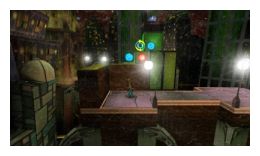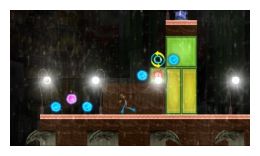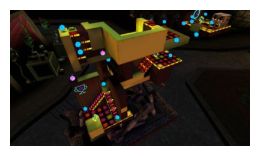 Crush, developed by Zoë Mode and distributed by Sega, is a platform puzzler for the Playstation Portable, and may be one of the most unique, challenging, and playable games for the system in a long time. The game features the ability to “crush” a 3D level down into a 2D platformer, along the lines of Super Paper Mario but with many different elements and tactics that can be used. It is not easy, but nor is it difficult nor unforgiving, and really makes for a great puzzle game for the PSP.
Crush, developed by Zoë Mode and distributed by Sega, is a platform puzzler for the Playstation Portable, and may be one of the most unique, challenging, and playable games for the system in a long time. The game features the ability to “crush” a 3D level down into a 2D platformer, along the lines of Super Paper Mario but with many different elements and tactics that can be used. It is not easy, but nor is it difficult nor unforgiving, and really makes for a great puzzle game for the PSP.
Story: B+
The story for Crush feels more like a way to explain why there’s puzzles to be solved, and doesn’t really feel tied in well with the actual gameplay. Danny, the protagonist, is a teenager that has a bad case of insomnia, and turns to mad scientist Dr. Reuben and his virtual reality device called C.R.U.S.H. to help him deal with the fears and memories of his past that is preventing him from sleeping. Danny’s problem seem simple, but as the C.R.U.S.H. unit plays Danny’s mind against him more, deeper darker fears are found to exist within Danny’s mind. Cutscenes using flat 2D stills with the Ken Burns effects and voice-overs are used to progress the story after certain levels.
Gameplay: A
Crush plays as a 3D platformer puzzler. Each of the 40 levels has a number of colored marbles around the level (representative of their value), and you need to collect at least half of the total value out there to open an exit from the level. You control Danny that can jump a short distance and crotch, and can also push round objects around. You can also swing the camera around to 5 angles; top down and from each of the 4 sides to get a better look at the level.

 However, Danny has another ability granted to him by the C.R.U.S.H. simulation; by activating it, he can cause the current 3D view to “crush” down into a 2D view (an example of a 3D to 2D is shown here). You can’t crush into a situation where Danny is stuck in a wall or hidden, but once crushed, you can move about the 2D version of the level. By crushing to 2D, you can make pathways that don’t exist in 3D, or you can make your way up to higher platforms that jumping cannot get you there. Uncrushing can be done most everywhere, again with a mechanism to prevent you from being “pushed” off the level. Via crushing and uncrushing, you can collect more marbles and work your way to the exit. From doing this, it becomes easy to see that there are visual clues on the blocks as to what will happen when they are crushed; some blocks will allow you to walk through them as empty space, others are treated as impassible walls, and then there are those that turn invisible when crushed. Thus, by looking around and seeing how the crushing action will create a 2D pathway, you can work your way around each level.
However, Danny has another ability granted to him by the C.R.U.S.H. simulation; by activating it, he can cause the current 3D view to “crush” down into a 2D view (an example of a 3D to 2D is shown here). You can’t crush into a situation where Danny is stuck in a wall or hidden, but once crushed, you can move about the 2D version of the level. By crushing to 2D, you can make pathways that don’t exist in 3D, or you can make your way up to higher platforms that jumping cannot get you there. Uncrushing can be done most everywhere, again with a mechanism to prevent you from being “pushed” off the level. Via crushing and uncrushing, you can collect more marbles and work your way to the exit. From doing this, it becomes easy to see that there are visual clues on the blocks as to what will happen when they are crushed; some blocks will allow you to walk through them as empty space, others are treated as impassible walls, and then there are those that turn invisible when crushed. Thus, by looking around and seeing how the crushing action will create a 2D pathway, you can work your way around each level.
Along the way, crushing can reveal new items. Each level has a puzzle piece that unlocks artwork that is usually difficult to get or well hidden. Special signs on walls remain inactive when in 3D, but when visible while crushed, can make a trophy appear (unlocking a trophy mode for that level), prevent you from uncrushing, or improve your jumping height. Some levels feature an alarm clock that activates when crushed in the right way, requiring you to jump down onto it to stop or else restart from the last checkpoint. Gears that turn to activate platforms may only mesh when crushed. A few levels also feature monsters that behave differently in crushed and uncrushed mode; for example, one becomes a usable block while crushed but otherwise is a menace; another type you can cage when crushed, and the uncrush to close the cage and trap the nasty. There’s also switches, some that require large spheres or cylinders to trip them. Along the way as you process through the levels, tutorials will help to explain new features and the effects of crushing on those. A huge benefit of this game compared to other platform puzzlers is that there is no time limit for each level beyond the alarm clock noted above, and that there are numerous checkpoints that you just have to touch along the way. Should you get crushed by solid walls. fall off the level or from a large height, you’ll start at the last checkpoint you touched, thus not wrecking a lot of work that you may have put in before.
 Once you’ve completed a level, you’re scored on how many marbles you’ve collected, how much time you took, and how many crushes you used. Each level also features a trophy and puzzle piece, and by getting the trophy, you can try the trophy mode for that level, in which you have to get out within a fixed time limit and with a limited number of crushes available to you. You can go back to any level at any time to try to improve your score and collect the trophy and puzzle piece as well.
Once you’ve completed a level, you’re scored on how many marbles you’ve collected, how much time you took, and how many crushes you used. Each level also features a trophy and puzzle piece, and by getting the trophy, you can try the trophy mode for that level, in which you have to get out within a fixed time limit and with a limited number of crushes available to you. You can go back to any level at any time to try to improve your score and collect the trophy and puzzle piece as well.
The game uses the analog nub for movement, and the directional buttons for rotating the camera around to the orthogonal angles; the left shoulder is used for crushing and uncrushing, and the buttons are used for crouching, pushing and jumping. The game is very forgiving in that you cannot walk off the edge of the level (thus making up for sometimes tricky views and the inaccuracy of the analog nub), though you can jump off, but again, you’ll appear at the last checkpoint that you passed. As there is no timer (beyond the alarm clocks), you also can experiment a lot more to figure out how to solve a level as well as accounting for missteps in controlling Danny. I never got frustrated at the controls or the game, only with my inability to see the solutions, so I consider this to be an outstanding feature of a PSP game. The game has an excellent learning curve in that you start to learn tricks in early levels that become key points to watch for in latter ones, but after the first few levels, there’s not a lot of obvious approaches to completing a level, requiring you to experiment freely to figure out what you can do.
Obviously, the idea of 2D/3D platforming is very similar to the recently released Super Paper Mario, but the games have very different twists on the dimensional shifting. To say that Crush is copying the Super Paper Mario approach is incorrect, though certainly the idea may have been inspired by it. There may be a few puzzles that are common in both games (platforms that exist in 3D that don’t in 2D or vice versa), but the idea of flattening the 3D level down to 2D as in Crush is really done in a unique manner.
Value/Replayability: A
Forty levels may seem rather short, but some of these levels took a good 15 to 30 minutes to figure out how to move about and crush correctly, and I would say just running through completing the levels without attempting high scores or all the extras took a good 10 to 15 hours. I certainly can see that there would as much time trying to grab everything and then attempting the trophy mode levels. The game definitely is sized just right for a portable puzzle game. An editing mode would have been nice for user-created puzzle levels, but hopefully a sequel will allow for this.
Graphics: A-
The game is presented in a slightly-lower polycount 3D mode than what I’ve seen the PSP handles, but it certainly is not a deterrent to the game. It is a bit dark at times, in that it can be hard to determine the difference between walls that will disappear when crushed and those that become walls due to shadows in 3D mode; everything else is usually brightly colored to make the difference easier. The camera does its best job to follow you; if you walk between two walls, it will swing to a top-down view to make it easier to follow you, but you can always force the camera to a specific angle.
Sound: B
The background music is a little odd, basically sounding like a drug-induced cacophony related to the current theme (out of 4) that you’re in. The game does use voice-overs for the cutscenes which does help to prevent the story from being just a weak add-on to the game.
Overall: A
Crush may have a few minor faults in the story, visual and audio areas, but these are minor compared to the excellent puzzling experience that the game has. The game is well-suited to the PSP and in fact prevents punishing the player for some of the lacking of the PSP controls. The puzzles are not simple, but do lead you along a well-developed learning curve to make your way through the game, giving you a good sense of accomplishment for figuring out the solutions. While it’s not a system-selling game, Crush is definitely a game to look to have if you already have a PSP.
Filed under: crush, playstation-portable, puzzle, review |



Leave a comment